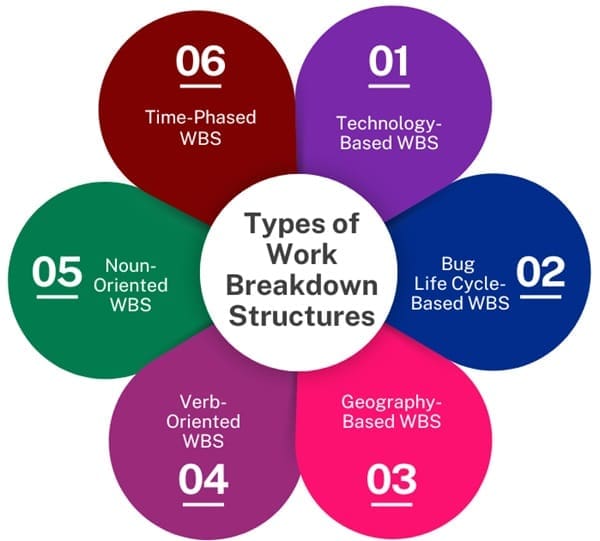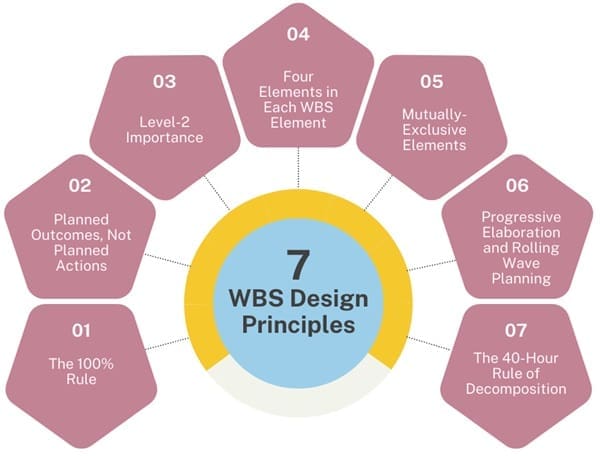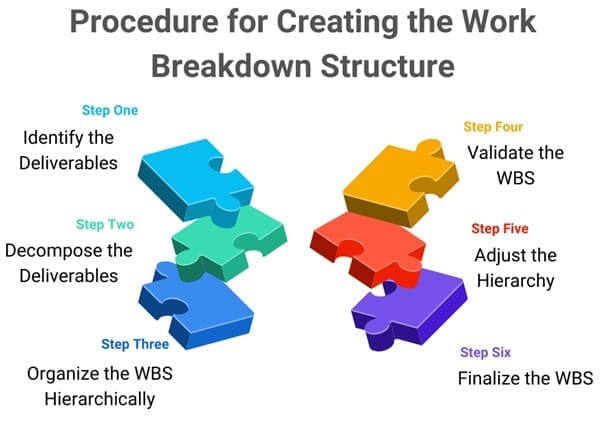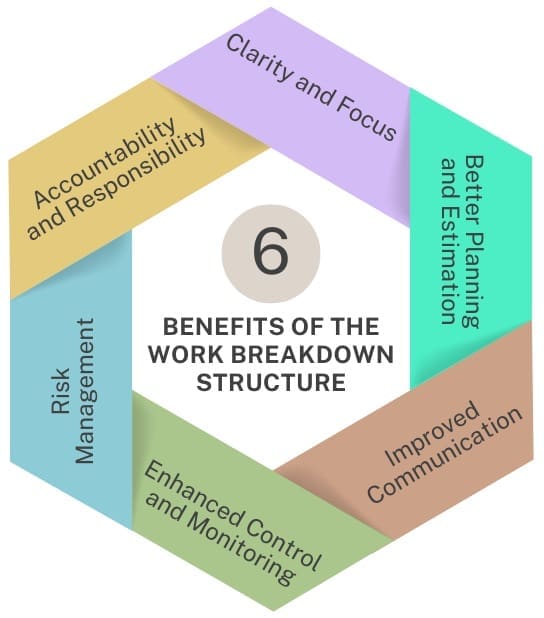A Work Breakdown Structure (WBS) is an essential tool in project management that serves as a hierarchical decomposition of the total scope of work required to complete a project. It is a product-oriented framework that breaks down the project into smaller, more manageable components or tasks, organized in a logical hierarchy.
This systematic approach helps manage the project efficiently. It also ensures that we clearly define, track, and control all the project’s objectives and deliverables throughout the project life cycle.
Table of contents
- Work Breakdown Structure (WBS)
- Purpose of the Work Breakdown Structure
- Types of Work Breakdown Structures
- Scope of the Work Breakdown Structure
- WBS Design Principles
- Structure of the Work Breakdown Structure
- Responsibility in Creating the Work Breakdown Structure
- Process for Creating the Work Breakdown Structure
- Importance of the Work Breakdown Structure
- Work Breakdown Structure and Project Milestones
- Benefits of the Work Breakdown Structure
- Work Breakdown Structure and Project Management Tools
- Final Words
- Related Articles
Work Breakdown Structure (WBS)
The Work Breakdown Structure (WBS) serves as a critical tool for defining and organizing the total scope of a project. By breaking down a project into manageable sections, the WBS allows all stakeholders—customers, suppliers, project teams, and other participants—to communicate more effectively throughout the project life cycle.
This taxonomy of the project not only aids in organizing work but also ensures that every aspect of the project is accounted for, leading to better planning, execution, and monitoring.
Purpose of the Work Breakdown Structure
The primary purpose of a Work Breakdown Structure is to simplify the management of complex projects by breaking down the project into smaller, manageable sections. This separation allows for more accurate tracking of the project’s cost, time, and technical performance at all levels of the project.
By breaking down the project into components, the WBS helps project managers and teams understand the scope of the work required, assign responsibilities, and monitor progress effectively. Moreover, it provides a structured vision of what the project entails, helping stakeholders understand the project at different levels of detail.
Types of Work Breakdown Structures

Different projects may require different types of WBS structures depending on the nature of the work, the organizational context, and the specific requirements of the project. Below are some of the common types of WBS structures:
Technology-Based WBS
This type of WBS proves especially useful for projects with high specialization, like those in the high-tech sector. It organizes the work based on the different technologies involved. Specialized professionals lead each technology-related activity, maintaining consistent standards of quality and performance across all project locations.
This structure fits organizations with a functional hierarchy and a preference for strong central control.
Life Cycle-Based WBS
We organize this WBS by the various stages of the project life cycle. Although not commonly used, it proves effective in projects where timing and sequential order of activities are critical.
For example, in a construction project, we break the WBS down into stages such as design, infrastructure development, and final delivery. We further subdivide each stage into relevant categories, continuing this process until we define all work packages.
This structure benefits projects outsourced to multiple subcontractors, with each contractor handling a specific phase of the project.
Geography-Based WBS
A geography-based WBS divides the project work by location, which is ideal for projects involving multiple sites, such as the construction of several plants in different countries. Each plant manager is responsible for the entire scope of work required to establish their respective plant, making this WBS structure suitable for decentralized management practices.
This approach allows for the customization of work processes to fit local conditions, such as culture, language, and legal requirements.
Verb-Oriented WBS
In a verb-oriented WBS, the focus shifts to the actions required to produce the project deliverables. Each element in the WBS starts with a verb (e.g., design, develop, test), clearly indicating the work needed. This task-oriented structure suits projects that emphasize the process over the final product.
Noun-Oriented WBS
Also known as a deliverable-oriented WBS, this structure defines project work in terms of the components that make up the deliverable. The elements in this WBS are usually nouns (e.g., Module A, Engine, Antenna), representing parts of the final product.
This type of WBS is preferred in projects where the emphasis is on the final product rather than the process. It aligns with the PMI’s definition of a deliverable-oriented WBS.
Time-Phased WBS
Long-term projects use this structure to break the work into major phases rather than tasks. The time-phased WBS works best for projects that plan work in waves, focusing detailed planning only on the near-term phase. This approach allows for flexibility in managing long-term projects, with progressive elaboration as the project evolves.
Other WBS Types
Additional types of WBS structures may include organization-based, geographical-based, cost breakdown, and profit-center-based structures. Each of these structures has its own unique application depending on the specific needs and context of the project.
Scope of the Work Breakdown Structure
The scope of the WBS is comprehensive and includes all the activities, tasks, and deliverables required to complete the project. It is a hierarchical representation that covers every aspect of the project work, ensuring that nothing is overlooked.
The WBS is product-oriented, meaning it focuses on the end products or deliverables that the project aims to achieve. Each level of the WBS represents a more detailed breakdown of the project, with the highest level representing the overall project and subsequent levels representing finer details.
This detailed breakdown ensures that all aspects of the project are covered, from major deliverables down to individual tasks.
WBS Design Principles

The design of a WBS must adhere to several key principles to ensure its effectiveness. These principles guide the development, decomposition, and evaluation of the WBS, ensuring that it accurately represents the project’s scope and objectives.
The 100% Rule
One of the most important principles in WBS design is the 100% Rule. This rule states that the WBS must include 100% of the work defined by the project scope and capture all deliverables, including internal, external, and interim deliverables.
The 100% Rule ensures that the WBS covers the entire scope of the project without leaving out any necessary work or including unnecessary tasks. It applies at all levels of the WBS hierarchy, ensuring that the sum of the work at the child level equals 100% of the work represented by the parent node.
Planned Outcomes, Not Planned Actions
To adhere to the 100% Rule, define WBS elements in terms of outcomes rather than actions. Outcomes represent the desired results of the project, such as a product or service, and we can predict them accurately.
In contrast, actions are the steps we take to achieve these outcomes and may be harder to predict accurately. By focusing on outcomes, the WBS remains flexible, enabling creative problem-solving and innovation throughout the project.
Level-2 Importance
Of all the levels in a WBS, Level-2 is often the most critical. It groups actual costs and schedule data for future project cost and schedule estimating. We use Level-2 elements to capture actuals from a project, and then we use these for future estimating purposes.
For example, a project manager may want to know how much it took to design a product after completion to use that data for analogous estimating in future projects.
Four Elements in Each WBS Element
Each WBS element should contain the following four items:
- The scope of work, including any deliverables.
- The beginning and end dates for the scope of work.
- The budget for the scope of work.
- The name of the person responsible for the scope of work.
By ensuring that each WBS element includes these four items, the project manager can decompose the project into manageable, assignable portions, minimizing confusion and ensuring clarity among project team members.
Mutually-Exclusive Elements
It is crucial that there is no overlap in scope definition between the two elements of a WBS. Overlapping scopes can lead to duplicated work, miscommunication about responsibility and authority, and confusion in project cost accounting. To avoid this, WBS element names should be clear and unambiguous. A WBS dictionary can also help clarify the distinctions between WBS elements.
Progressive Elaboration and Rolling Wave Planning
Decompose the WBS to the work package level, the lowest point where you can reliably estimate costs and schedules. Refine WBS details progressively before starting work on an element of the project. Use rolling wave planning in large projects to develop the WBS in waves. Perform detailed planning for near-term phases and general planning for distant future phases.
The 40-Hour Rule of Decomposition
To determine how far to decompose a WBS, follow the 40-Hour Rule. This rule advises that each WBS element should represent work achievable within 40 hours or less. By doing so, you ensure the work is broken down into manageable portions. This approach prevents the work from being either too broad or too granular.
Also See: Lean Six Sigma Certification Programs, Wichita, Kansas
Structure of the Work Breakdown Structure
The WBS organizes and visually represents the work to be accomplished in logical relationships through a multi-level framework.
Each descending level of the WBS provides a more detailed definition of a project component. The WBS structure and coding integrate and relate all project work, and we use them throughout the project life cycle to identify, assign, and track specific work scopes.
We typically structure the WBS hierarchically, starting with the highest level that represents the entire project. We then break this level down into major deliverables and further divide those into smaller, more detailed components.
At the final level, we break the work into individual tasks or activities that we can assign, track, and control.
Responsibility in Creating the Work Breakdown Structure
The Project Manager primarily creates the WBS, drawing input from other project team members. The Project Manager must ensure the WBS accurately reflects the project scope and provides sufficient detail for effective project management.
To create the WBS, the Project Manager identifies the deliverables from the project charter, statement of work, or other project documentation and then decomposes these deliverables into their component parts. This process involves careful consideration and collaboration with the project team to ensure it covers all aspects of the project and remains logical and coherent.
Process for Creating the Work Breakdown Structure
Here we are going to discuss the steps for developing a WBS:

1. Identify the Deliverables:
The first step in creating a WBS is to identify the project deliverables. These are the major outputs that the project aims to produce. The project charter, statement of work, or other project documentation can provide a list of these deliverables. These deliverables become the highest-level entries within the WBS.
2. Decompose the Deliverables:
Identify the deliverables first. Next, decompose them into smaller, manageable components. Continue breaking them down until you have tasks or activities that can be assigned and tracked. Each component must be logically distinct and clearly understood by everyone involved in the project.
3. Organize the WBS Hierarchically:
The WBS is then organized hierarchically, with the project as the top level, followed by major deliverables, and then further decomposed into smaller components.
4. Validate the WBS:
Create the WBS first. Validate it to ensure it includes all necessary work. Use a bottom-up approach to check if each task contributes to higher-level deliverables. Add any missing tasks to the WBS.
5. Adjust the Hierarchy:
If necessary, the hierarchy of the WBS should be adjusted to reduce the number of levels and make the structure more coherent. The goal is to ensure that the WBS is as simple as possible while still covering all aspects of the project.
6. Finalize the WBS:
After the WBS has been validated and adjusted, it is finalized and included in the Project Execution Plan (PEP). The finalized WBS serves as the basis for all future project planning, execution, monitoring, and control.
Importance of the Work Breakdown Structure
A well-constructed WBS is crucial for the success of any project. It provides a clear roadmap of what needs to be done and how it will be accomplished. Without a well-defined WBS, projects are at risk of failure due to unclear work assignments, scope creep, budget overruns, and missed deadlines.
The WBS is the foundation for all project management processes, including planning, executing, and controlling. It also serves as a communication tool, helping to ensure that all stakeholders have a clear understanding of the project and its objectives.
The design of the WBS at the early stage of the project life cycle is pivotal to the project’s success. The structure chosen for the WBS has far-reaching implications, affecting organizational structures, management practices, and future coordination among the various teams involved in executing the work packages.
A mismatch between the WBS, Organizational Breakdown Structure (OBS), and the management style of the project manager can lead to project delays, budget overruns, and other issues that may compromise the overall success of the project.
A well-designed WBS ensures that all work required to complete the project is clearly defined and structured in a way that is understandable and manageable. It also prevents the inclusion of unnecessary tasks and avoids duplication of effort.
The designer of the WBS plays a crucial role in setting the foundation for effective project management, and the choices made during the WBS design process can significantly influence the project’s outcome.
Work Breakdown Structure and Project Milestones
The WBS closely links to project milestones, marking significant points in the project timeline that signal the completion of key deliverables. The project team can associate each work package or WBS component with a milestone. This association helps track progress and identify any issues early on.
Milestones provide a clear indication of how the project is progressing and can help in taking corrective actions if necessary. They also serve as a means of communicating progress to stakeholders and ensuring that the project is on track.
Benefits of the Work Breakdown Structure

- Clarity and Focus: The WBS provides a clear overview of the project, helping the project team and stakeholders understand the work involved and how it will be accomplished. It ensures that everyone is on the same page and that the project remains focused on its objectives.
- Better Planning and Estimation: By breaking down the project into smaller components, the WBS helps in more accurate planning and estimation of costs, time, and resources. It allows project managers to allocate budgets and resources more effectively and develop a realistic project schedule.
- Improved Communication: The WBS serves as a communication tool, helping to ensure that all stakeholders have a clear understanding of the project and its objectives. It provides a common language for discussing the project and ensures that everyone is working towards the same goals.
- Enhanced Control and Monitoring: The WBS allows for better control and monitoring of the project by providing a clear structure for tracking progress. It helps in identifying any issues or delays early on and allows for corrective actions to be taken before they impact the project.
- Risk Management: The WBS identifies potential risks by highlighting poorly defined areas of the project. You can track and manage these risks throughout the project. This approach helps ensure the project’s successful completion.
- Accountability and Responsibility: The WBS clearly defines who is responsible for each component of the project, ensuring that there is accountability at all levels. This helps in avoiding confusion and ensures that tasks are completed on time and to the required standard.
Work Breakdown Structure and Project Management Tools

The WBS closely links to other project management tools, including the Project Charter, Resource Breakdown Structure (RBS), WBS Dictionary, and Network Diagram. These tools collaborate to ensure thorough project planning. They also help in executing and controlling the project effectively.
- Project Charter: The WBS is based on the Project Charter, which outlines the project’s objectives and scope. The high-level elements of the WBS should match the nouns used in the Project Charter to describe the project’s outcomes.
- Resource Breakdown Structure (RBS): The RBS describes the project’s resource organization and works with the WBS to define work package assignments. This ensures effective resource allocation. It also helps keep the project on track.
- WBS Dictionary: The WBS Dictionary provides detailed information about each element of the WBS, helping to clarify the work involved and ensuring that there is no ambiguity.
- Network Diagram: The Network Diagram is a sequential arrangement of the work defined by the WBS. It helps in visualizing the project schedule and identifying any dependencies between tasks.
Final Words
The Work Breakdown Structure is a fundamental tool in project management that provides a clear and structured approach to managing complex projects. It breaks down the project into manageable components, allowing for better planning, control, and communication.
The WBS ensures that all aspects of the project are covered, and clearly defines and assigns the work. This helps deliver successful projects on time, within budget, and to the required quality standards. It is crucial in project management, forming the foundation for all planning, execution, and monitoring activities.

About Six Sigma Development Solutions, Inc.
Six Sigma Development Solutions, Inc. offers onsite, public, and virtual Lean Six Sigma certification training. We are an Accredited Training Organization by the IASSC (International Association of Six Sigma Certification). We offer Lean Six Sigma Green Belt, Black Belt, and Yellow Belt, as well as LEAN certifications.
Book a Call and Let us know how we can help meet your training needs.



















